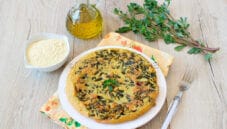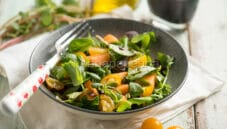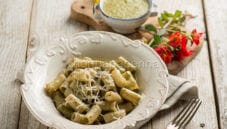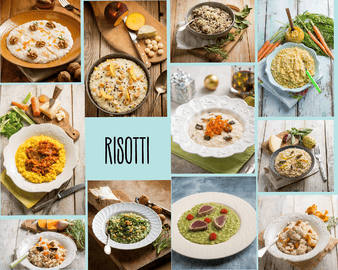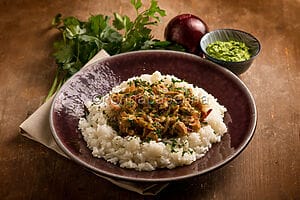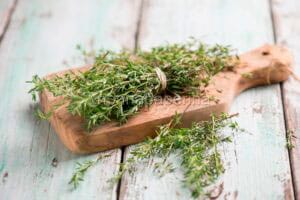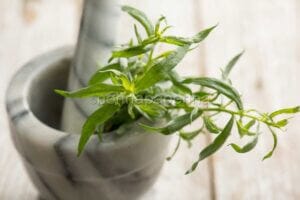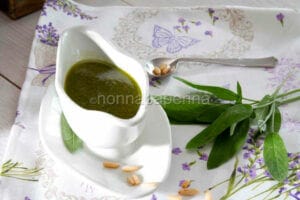
Omelette roll with purslane, a healthy recipe
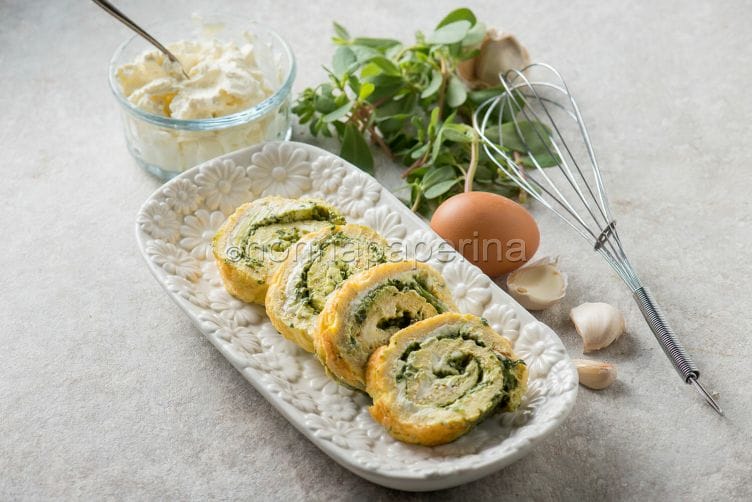
Discover purslane, an edible plant.
Purslane (Portulaca oleracea) is a herbaceous and weedy succulent plant belonging to the Portulacaceae family. It is characterised by fleshy, oval-shaped leaves, grows easily in sunny environments, and requires little water.
The Portulaca grows well in a warm environment and has no problems with the hot, dry climate of our summers. It is a plant that must be sheltered at the beginning of autumn and then placed in an indoor environment during the winter.
Recipe rotolo di frittata con portulaca
Preparation rotolo di frittata con portulaca
- To prepare the omelette roll with purslane and goat’s cheese, start by removing 300 g of purslane leaves from the sprig.
- After cleaning them thoroughly, add salt, olive oil, and a clove of garlic to a pan and let them season.
- When the purslane is cooked, remove the garlic and blend everything until you obtain a fairly thick and homogeneous cream.
- Now take a fairly large bowl and put the eggs, the grated Parmigiano Reggiano, and a little salt in it.
- Mix carefully with a fork, and pour the mixture onto a baking tray lined with baking paper.
- Cook for 15 minutes at 150 degrees. Once cooked, place the omelette on the work surface and cover the entire surface with the spreadable cheese and purslane cream.
- To make the omelette firmer, roll it up, cover it with clingfilm, and refrigerate for one hour.
- Slice the roll after removing the film, which should have been done by now. Proceed to serve and enjoy your dish.
Ingredients rotolo di frittata con portulaca
- 300 gr. of fresh purslane leaves
- 6 eggs
- 1 pack of fresh Exquisa creamy goat cheese or lactose-free
- 2 tablespoons of 24-month Parmigiano Reggiano
- 1 clove of garlic
- 3 tablespoons extra virgin olive oil
- a pinch of salt
How to prepare an omelette roll with purslane
Let’s prepare the omelette roll with purslane, an edible and healthy plant whose origins are lost in the mists of time… In fact, the history of purslane dates back a long time. Presumably originating from Asia, it appears to have been used as medicine by the ancient Egyptians, and it was served on tables during the Middle Ages.
Despite being very common in our vegetable gardens, fields, and gardens, it is still rarely used. Known across Italy by several names—purslane plant, porcellana or grass herb in Lombardy, porcacchia in Lazio and Marche, and precacchia in Abruzzo, to name a few—it is still underutilized. This is unfortunate because it has so many benefits, and its adaptability in the kitchen is greatly appreciated.
Where can you buy edible purslane? It is usually harvested in the fields. It is a spontaneous plant that is found throughout Italy and is easy to find, even in the city. It is also considered a flowering plant, and many people keep it on their balconies. Purslane flowers can be red or yellow.
Because of its infesting power, I strongly advise against putting it on the balcony of your house. Purslane Grandiflora is grown for its flowers. Its seeds are larger and easier to collect than those of the Oleracea variety.
The therapeutic properties of purslane
Purslane has recognised diuretic, purifying, thirst-quenching, anti-diabetic, and anti-cholesterol properties. Rich in fibre, it has very few calories—16 kcal per 100 grammes. Furthermore, it contains vitamin A, some B vitamins, vitamin C, mineral salts such as magnesium, manganese, phosphorus, zinc, selenium, iron, calcium, potassium, sodium, and copper, and is a source of polyunsaturated fatty acids of the omega-3 type, as well as flavonoids and a-linoleic acid. In addition, it improves vision and skin health.

In fact, in the first case, thanks to vitamin A (retinol) and beta-carotene, it provides powerful antioxidants and essential substances for the well-being of our eyes. Purslane eliminates free radicals that attack eye cells and cause macular degeneration and cataracts.
Wild purslane, also known as porcelain or porcacchia, is an annual creeping plant with rosettes of thick and pulpy leaves. It grows wild in India, where it has been eaten for thousands of years. It now grows practically everywhere in North and South America. It is grown throughout southern Europe and the Middle East, though less so there. Today, it is uncommon in England, while it was popular at the time of Elizabeth I. Is purslane an edible plant? Purslane Oleracea, also known as wild purslane, is also edible. The only one to watch out for is the poisonous purslane, also known as hemlock. It is recognisable due to the unpleasant odour that emits when the stem is broken; its roots are large and white.
The plant needs warm, dry soil and lots of sun; sowing every month during the summer provides a continuous supply. It is necessary to arrange the rows at a distance of 30 cm from each other, leaving 15 cm between one plant and the next. There are several varieties, some of which have golden leaves.
In the East, purslane is usually eaten cooked, but it also makes an excellent salad vegetable and is eaten raw in France. In the Middle East, it is sometimes found in a mixed salad (which also contains bread) called fattoush. Because purslane has thick, pulpy leaves, it is sometimes pickled, and there are many old English recipes for this purpose.
It is also very good from a culinary point of view. Now, let’s see some uses of this precious wild herb (whose flowers my grandmother ate, and, at the time, I made fun of her).
Purslane recipes and uses in the kitchen, tasty and healthy dishes
How do you cook purslane? Purslane can be eaten cooked or raw; every part of the plant is edible: the leaves, the flowers, the seeds (often consumed in salads), and the tender stems. Let’s see how to use it in the kitchen. There are approximately 40 species of purslane.
The tenderest leaves and branches are especially good eaten raw in mixed salads and rocket leaves (after thoroughly washing and rinsing) or combined with other greens in the kitchen.
Once blanched and flavoured in a pan, it is the ideal condiment for pasta-based first courses, omelettes, fillings, and original pestos, as well as being perfect if added to potatoes to prepare delicious gnocchi. Furthermore, cut into pieces, it can then be preserved either in brine or in vinegar.
If we travel back in time to the first half of the twentieth century, we find that purslane was one of the most popular ingredients in “poor” cuisine in Southern Italy. However, in Neapolitan cooking, it was customarily paired with rocket to make salads.
Purslane, also known as porcelain herb, is a main ingredient in summer salads in Sicilian cooking, usually paired with tomatoes and cucumbers. Lastly, it was a component in the mixture of salads and herbs that comprised a mixed salad in ancient Roman cuisine.
Here are other delicious recipes
Pasta with purslane pesto. A first course that is part of the tradition of Italian pasta is enriched with a pesto based on this exquisite herb. It is a tasty and exotic dish.
Lasagna with wild herbs. In this recipe, purslane is one of the main ingredients, and its flavour clearly emerges. Purslane has an effect on appearance as well, as the lasagna’s vivid green colour demonstrates.
Omelette with chickpea flour and purslane. A full-bodied omelette with a rustic flavour, but also very easy to prepare.
How to care for the plant in the winter
Caring for purslane during the winter months is a crucial step in ensuring that this plant, with its roots firmly planted in Mediterranean regions and even places with more temperate climates, can survive the “almost tropical” conditions it is used to enjoying. Although purslane shows remarkable resistance to drought periods and demonstrates a remarkable ability to adapt to water scarcity, the winter season can prove to be a challenge for its health. This plant is particularly vulnerable to the rigours of winter, especially when found in non-mild environments. Often, a brief frost is enough to compromise its integrity.
Among the most significant challenges that purslane faces during the cold season are cold winds that often cause it to dry out quickly. Therefore, it is essential to take precautions to ensure this plant continues to thrive even during the colder months.
One of the most common options for protecting purslane in the winter is to move the pot indoors. However, it is essential to place it in a sunny area so that the biochemical processes fundamental to its development can be preserved. If this solution is not practical, you can create a temporary shelter for the plant outdoors. This shelter can serve to protect it from cold winds and minimise the risk of damage caused by low temperatures.
In summary, wintertime purslane maintenance calls for careful thought and effort. It is imperative to maintain the health and vigour of this nearly tropical plant by providing an appropriate habitat, even during periods of low emperatures. Purslane’s beauty and prosperity in the spring will repay your care and attention to detail, whether you decide to bring it inside or give it an outdoor haven.
Is there any other herb similar to purslane?
To answer this question, it is good to take into consideration the flavour of purslane, which is rather delicate but still characteristic. It expresses vaguely salty and slightly sour notes, which make it pleasant on the palate. By virtue of this, purslane can be replaced with a rather limited range of foods. Since rocket leaves are so pungent that they almost seem salty yet are far from acidic, they can be a good choice for you.
Another “herb” capable of replacing (at least on paper) purslane is sorrel, which may appear a little more acidic and less edible. The same is true of borage, which is more flavorful even though it doesn’t contain any salt. However, because of its slight acidity, it tastes a bit like cucumber. Anyway, borage’s uses are exactly the same as purslane’s—that is, it may be used to produce delicious pesto and omelettes.
Omelette roll with purslane, a unique recipe
The omelette roll with purslane and goat’s cheese is not just any omelette; in fact, it is an omelette rolled up and sliced so that the filling clearly emerges. In this way, the chromatic tones are also highlighted, ranging from the yellow of the eggs to the white of the spreadable cheese to the green of the purslane.
Secondly, it is a unique omelette as it has purslane among the ingredients, an edible plant with a rich cultural history behind it. It’s only been truly rediscovery recently, encompassing the herbal industry as well as culinary. Because of its anti-inflammatory properties, purslane is actually a medicinal plant as well.
It’s a nutritious herb that can complement or replace large green vegetables for the remainder of the diet. It defends itself quite well nutritionally, and it does have some unusual characteristics. Above all, this type of vegetable is rich in omega-3 fatty acids, which are generally lacking in other vegetables and are beneficial to the heart, eyes, and brain.
Purslane is also rich in antioxidants, which reduce oxidative stress and support cellular reproduction mechanisms. The presence of vitamins and mineral salts is also good, in particular vitamin C and potassium. The fibre content is excellent, useful for the good health of the digestive system and for resolving the mildest cases of constipation.
Do we have recipes for purslane? Of course, yes!
COULD IT BE INTERESTING FOR YOU

Chicken Yassa, a spicy and tasty Senegalese dish
Discovering Yassa chicken Yassa is a Senegalese dish made with chicken and rice, a complete dish that is appreciated for the variety of flavours and the massive use of spices. The recipe is...
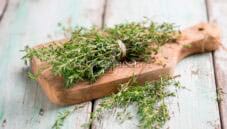
All about thyme, the aromatic herb that tastes...
Everything from the proper foundation to the components that provide value Tartlets with carrot, celeriac, and thyme can be prepared in around 40 minutes (20 minutes of prep + 20 minutes of...
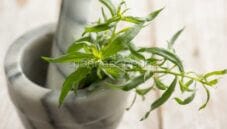
Tarragon: a strong and pungent flavour
Tarragon, from Asia Minor to Italy Artemisia Dracunculus, an aromatic herbaceous plant belonging to the Asteraceae family, is the source of tarragon, a spice that is native to Central...



